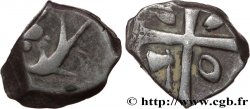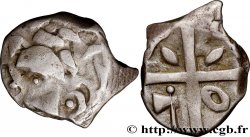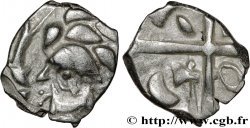bga_185731 - GALLIA - SOUTH WESTERN GAUL - VOLCÆ TECTOSAGES (Area of Toulouse) Drachme de style hybride entre “cubiste et romanisé”, S. 69
Not available.
Item sold on our e-shop (2009)
Price : 95.00 €
Item sold on our e-shop (2009)
Price : 95.00 €
Type : Drachme de style hybride entre “cubiste et romanisé”, S. 69
Date: IIe siècle av. J.-C
Metal : silver
Diameter : 16 mm
Orientation dies : 12 h.
Weight : 3,56 g.
Rarity : R3
Coments on the condition:
Flan large mais frappe décentrée au droit comme au revers. Le droit sort d’un coin usé et le revers d’un coin de qualité. Patine sombre et hétérogène, surtout au revers
Catalogue references :
Predigree :
Cette drachme provient de la collection personnelle de G. Savès et du trésor de Béziers découvert en 1871 (acquise parmi les 37 monnaies de la collection Charra - cf. Savès page 97)
Obverse
Obverse legend : ANÉPIGRAPHE.
Obverse description : Tête à gauche ; le menton en galoche, le nez fort ; chevelure retombant sur l'oreille avec des mèches qui se rejoignent en chignon derrière la nuque ; un collier de perles à la base du cou ; deux dauphins stylisés devant la bouche.
Reverse
Reverse legend : ANÉPIGRAPHE.
Reverse description : Croix formée de quatre cantons ornés chacun d'une lunule : balle de fronde aux 1er et 2e cantons, une hache au 3e et un pendant en ellipse au 4e canton.
Commentary
Pour le S. 69 qui correspond à notre monnaie, G. Savès décrit une "tête à gauche, au dessin maladroit". Il semble que cette appréciation soit le fait d'un exemplaire de moindre qualité. L’exemplaire n° 602 de MONNAIES 29 présente un doit stylisé, mais de gravure élégante.
Les drachmes de ce type sont souvent liées par le coin de revers à des monnaies du type S. 55.
Les drachmes de ce type sont souvent liées par le coin de revers à des monnaies du type S. 55.








 Report a mistake
Report a mistake Print the page
Print the page Share my selection
Share my selection Ask a question
Ask a question Consign / sell
Consign / sell
 Full data
Full data



